The rise of Edge AI is set to redefine the way web applications are designed, developed, and used. Edge AI refers to the processing of artificial intelligence (AI) algorithms on devices that are located closer to the data source, rather than relying on distant cloud servers. This technology promises significant benefits in terms of speed, efficiency, and data security, making it an influential factor for the future of web applications. With the ability to analyze data in real-time, Edge AI is reshaping how businesses and users interact with web-based technologies. As the demand for smarter, faster, and more responsive applications increases, the integration of Edge AI will undoubtedly play a critical role in shaping the future of the web.

Enhancing Performance with Reduced Latency
One of the most notable benefits of Edge AI is its ability to significantly reduce latency by processing data closer to the user’s location. Traditional cloud-based AI models require sending data to centralized servers for processing, which can introduce delays, especially in regions with slower internet connections. By leveraging edge devices for data processing, Edge AI reduces the need for long-distance data transfers, ensuring faster response times and a more seamless user experience. This is particularly important for real-time applications like gaming, augmented reality (AR), and virtual reality (VR). As users demand faster, more responsive interactions, Edge AI will play a key role in delivering near-instantaneous experiences.
Data Privacy and Security Benefits
Edge AI offers significant improvements in data privacy and security, which are increasingly important concerns for both businesses and users. By processing data locally on edge devices, sensitive information doesn’t need to be sent to centralized servers, reducing the risk of data breaches. This local processing ensures that personal data remains within the user’s control, rather than being exposed during transmission over the internet. Additionally, Edge AI allows for more secure authentication and encryption practices, further enhancing the protection of user data. As data privacy regulations become stricter, Edge AI provides a valuable solution for complying with laws such as GDPR and CCPA.
Real-Time Data Processing for Smarter Web Applications
Edge AI’s ability to process data in real-time is a game-changer for web applications. In many cases, web applications rely on cloud servers to analyze data and provide insights to users, which can introduce delays. With Edge AI, data is processed instantly, enabling faster decision-making and smarter user interactions. This is particularly useful in applications like recommendation systems, fraud detection, and personalized content delivery. By incorporating Edge AI into web applications, businesses can offer highly responsive, data-driven experiences that are tailored to individual users.
7 Key Advantages of Edge AI in Web Development
- Reduced latency for faster response times
- Increased data privacy and security
- Real-time data processing for more intelligent applications
- Lower bandwidth usage by minimizing data transfer to the cloud
- Enhanced reliability due to local processing
- Scalability through distributed computing
- Improved user experiences with responsive, adaptive features
Watch Live Sports Now!
Dont miss a single moment of your favorite sports. Tune in to live matches, exclusive coverage, and expert analysis.
Start watching top-tier sports action now!
Watch NowTop Industries Benefiting from Edge AI
- Healthcare – Faster medical diagnostics and real-time patient monitoring
- Automotive – Autonomous vehicles with real-time decision-making capabilities
- Retail – Personalized shopping experiences with real-time inventory tracking
- Manufacturing – Predictive maintenance and smarter factory operations
- Finance – Fraud detection and secure transactions
- Smart Cities – Real-time monitoring of traffic, pollution, and infrastructure
- Media & Entertainment – Streamlined content delivery and immersive experiences
| Feature | Edge AI | Cloud AI |
|---|---|---|
| Latency | Low, near-instantaneous | Higher, due to data transmission |
| Data Privacy | Better, local data processing | Potentially compromised, data sent to servers |
| Bandwidth Usage | Lower, minimal data transfer | Higher, requires constant data exchange |
“Edge AI is not just a technological advancement—it’s a transformative force that is enabling businesses to create faster, more secure, and smarter web applications. By bringing AI processing closer to the user, Edge AI offers real-time, data-driven experiences that are reshaping how we interact with the web.”
As the world becomes more connected and data-driven, Edge AI will be instrumental in enabling the next generation of web applications. With benefits like lower latency, improved data security, and real-time processing, it’s clear that Edge AI is a key component for building next-gen applications. Web developers and businesses should start considering the integration of Edge AI into their projects to stay competitive and deliver superior user experiences. As this technology continues to evolve, staying ahead of the curve will ensure that your applications are not only faster and smarter but also more secure and privacy-conscious. Embrace the rise of Edge AI today, and share this article to spread the word about the transformative power it has for the future of web development.